Get ready for the most memorable Summer Camp
you will ever experience…
Each year the JLGB offers the most incredible and most talked about Summer Camp for Jewish young people across the UK
For over 120 years, the JLGB has consistently delivered high-quality Summer Camps attended by hundreds of young Jewish people not just from the UK but from around the world!
JLGB Summer Camp offers young people a well-balanced programme packed full of high octane adventure, fun activities and professional production extravaganzas.
You and your friends, old and new, will take part in a huge range of new and exciting adrenaline-filled activities including 40 foot climbing wall, a high ropes course, caving, mountain biking, water sports and much more.
If that lot doesn't tire you out, the nights are just as much fun! They are filled with talent shows, special guests including comedians and hypnotists, murder mystery games, discos, game shows, bonfires, BBQs, music and parties!
On Imagine Summer Camps you'll make friends for life, not just from your local area but from Jewish communities all over the UK and around the world.
An example day at camp is shown below, click on each of the headings to read more.
| Morning | Afternoon | Evening |
|---|---|---|
| Wake Up | Lunch | Dinner |
| Breakfast | Adventure Activities | Evening production |
| Team Development | Whole Camp Activity | Hot Chocolate |
| Group Meeting | Sports Competition | Social Time |
| Skills Workshop | Free Time | Bed Time |
You are woken each morning by one of your leaders. They will give you time to brush your teeth and tidy up the tent before breakfast. The tent will be inspected later that morning so you must make a good effort. If you've done a really good job you could be recognised for having the "Best Kept Tent" whilst earning points for your platoon.
We think it's vital to provide a good-quality balanced diet for everyone on camp - especially as you'll be running around using up a lot of energy. You'll get three hearty meals a day, served in the dining room where you'll be able to sit with your friends and catch up on all the fun you've been having.
Example Breakfasts: Cereal, Challah, Cheese, Toast, Eggy Bread, Cheese on Toast, Scrambled Eggs
Each day we bring everyone together for a parade (assembly) where the band plays and we hear the announcements of the day, we also practice for our open day display (march past).
The parade is very important so that everyone knows where they need to be during the day. Everyone must stand together in their platoons (groups) and be quiet whilst information for the day is read out.
This is a time where your leaders will see how you are doing and go through exactly what your platoon are doing that day
There are six zones of our unique Enterprise programme, (Learning & Creativity; Active and Healthy; Citizenship & Community; Social & Emotional; Leadership Development and Jewish Identity). You will get a chance to take part in various activities within these different sections
At Summer Camp, our talented chefs serve delicious meals freshly prepared on site to a set kosher menu. Given advance notice, we are happy to cater for those who are vegetarians or have special dietary needs - just make sure you mention it on your Application Form.
Example meals: Pasta (various sauces), Garlic Bread, Jacket Potatoes, Baked Beans, Pizza (various toppings), Chips, Beef/Veggie Burgers, Corn on Cob, Pasta Bake, Filled Rolls, Salads, Fruit
JLGB summer camps offer a wide range of activities to suit everyone. There are loads of different things to do, such as: mountain biking, archery, water sports, climbing, abseiling and survival skills, the list just goes on and on. This is where you will have the chance to choose which activities you take part in.
This is where everybody on camp joins together and takes part in one joint activity such as capture the flag.
While on camp we play a huge variety of sports such as football, cricket, rounders, hockey and even ultimate Frisbee.
This is time when you and your new friends can spend together where no other activities are planned and you can just relax and chill out.
Example meals: Soup, Kebabs, Turkey Schnitzel, Sausage Rolls, Fajitas, Roast Chicken, Chips, Latkes, Roast Potatoes, Rice, Salads, Fruit
JLGB camps are renowned for their stunning evening entertainment extravaganzas. From talent shows, to murder mysteries, from interactive game shows, to stunning late night discos - the fun just never stops! For those who prefer something quieter a film is shown most evenings.
To keep up with British tradition each evening before bed hot chocolate and biscuits will be available.
Every evening, after the younger members have gone to bed, those of you 15 or over get to enjoy an extra hour in the "Switch Mess".
Activities have been planned by a committee made up of some of your fellow members of the Mess.
If you are 15 by the 31st of August then you can join in with the Switch Mess.
Make sure you get a good night sleep, ready and recharged for the next day.
Apply Online Now!
Located on the River Thames, London has been a major settlement for two millennia, its history going back to its founding by the Romans. London is a leading global city, with strengths in the arts, commerce, education, entertainment, fashion, finance, healthcare, media, professional services, research and development, tourism and transport. London has a diverse range of peoples and cultures, and more than 300 languages are spoken within its boundaries. In 2012, London became the first city to host the Modern Olympic Games three times.
Enjoy the sights of London
After camp you will spend four days touring around London, seeings sites such as:
| Trafalgar Square | Horse Guards Parade | Big Ben | Houses of Parliament |
| Thorpe Park | South Bank / London Eye | Tate Modern | Science Museum |
| Leicester Square | Trocadero | Regent Street | Boat Tour |
| West End Show | Tower of London | Buckingham Palace | Natural History Museum |
| London Underground | Oxford Street | Hyde Park | Camden |
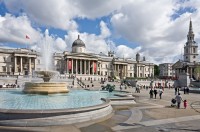 At the centre of Trafalgar Square is Nelson's Column, which is guarded by four lion statues at its base. There are a number of statues and sculptures in the square, with one plinth displaying changing pieces of contemporary art. The square is also used for political demonstrations and community gatherings, such as the celebration of New Year's Eve.
The name commemorates the Battle of Trafalgar (1805), a British naval victory of the Napoleonic Wars over France. The original name was to have been "King William the Fourth's Square", but George Ledwell Taylor suggested the name "Trafalgar Square".
At the centre of Trafalgar Square is Nelson's Column, which is guarded by four lion statues at its base. There are a number of statues and sculptures in the square, with one plinth displaying changing pieces of contemporary art. The square is also used for political demonstrations and community gatherings, such as the celebration of New Year's Eve.
The name commemorates the Battle of Trafalgar (1805), a British naval victory of the Napoleonic Wars over France. The original name was to have been "King William the Fourth's Square", but George Ledwell Taylor suggested the name "Trafalgar Square".
 Horse Guards Parade is a large parade ground off Whitehall. It is the site of the annual ceremonies of Trooping the Colour, which commemorates the monarch's official birthday, and Beating Retreat.
Horse Guards Parade is a large parade ground off Whitehall. It is the site of the annual ceremonies of Trooping the Colour, which commemorates the monarch's official birthday, and Beating Retreat.
 Big Ben is the nickname for the great bell of the clock at the north end of the Palace of Westminster in London and is generally extended to refer to the clock or the clock tower as well. The clock tower holds the largest four-faced chiming clock in the world and is the third-tallest free-standing clock tower.
Big Ben is the nickname for the great bell of the clock at the north end of the Palace of Westminster in London and is generally extended to refer to the clock or the clock tower as well. The clock tower holds the largest four-faced chiming clock in the world and is the third-tallest free-standing clock tower.
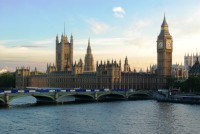 The Houses of Parliament or Westminster Palace as it is also known, is the meeting place of the two houses of the Parliament of the United Kingdom-the House of Lords and the House of Commons. It lies on the north bank of the River Thames in the heart of the London borough of the City of Westminster, close to the historic Westminster Abbey and the government buildings of Whitehall and Downing Street. The name may refer to either of two structures: the Old Palace, a medieval building complex, most of which was destroyed in 1834, and its replacement New Palace that stands today. The palace retains its original style and status as a royal residence for ceremonial purposes.
The Houses of Parliament or Westminster Palace as it is also known, is the meeting place of the two houses of the Parliament of the United Kingdom-the House of Lords and the House of Commons. It lies on the north bank of the River Thames in the heart of the London borough of the City of Westminster, close to the historic Westminster Abbey and the government buildings of Whitehall and Downing Street. The name may refer to either of two structures: the Old Palace, a medieval building complex, most of which was destroyed in 1834, and its replacement New Palace that stands today. The palace retains its original style and status as a royal residence for ceremonial purposes.
 Thorpe Park is one of Europe's best theme parks boasting some of the biggest and fasted rides, you will get the chance to spend a whole day at it!
Thorpe Park is one of Europe's best theme parks boasting some of the biggest and fasted rides, you will get the chance to spend a whole day at it!
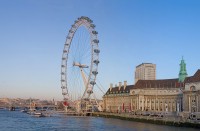 South Bank is an area of London, located immediately adjacent to the south bank of the River Thames. It forms a long and narrow section of riverside development that is within the London Borough of Lambeth and partly in the London Borough of Southwark. It is a significant tourist district in central London which stretches from the Design Museum in the east to the London Eye in the west. A series of central London bridges connect the South Bank to North London, including the more recent Golden Jubilee and Millennium pedestrian bridges.
South Bank is an area of London, located immediately adjacent to the south bank of the River Thames. It forms a long and narrow section of riverside development that is within the London Borough of Lambeth and partly in the London Borough of Southwark. It is a significant tourist district in central London which stretches from the Design Museum in the east to the London Eye in the west. A series of central London bridges connect the South Bank to North London, including the more recent Golden Jubilee and Millennium pedestrian bridges.
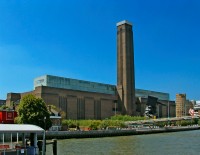 The Tate Modern is a modern art gallery located in London. It is Britain's national gallery of international modern art. It is the most-visited modern art gallery in the world, with around 4.7 million visitors per year. It is based in the former Bankside Power Station, in the Bankside area of Central London.
The Tate Modern is a modern art gallery located in London. It is Britain's national gallery of international modern art. It is the most-visited modern art gallery in the world, with around 4.7 million visitors per year. It is based in the former Bankside Power Station, in the Bankside area of Central London.
 Leicester Square is a pedestrianized square in the West End of London. In the middle of the Square is a small park, in the centre of which is a 19th century statue of William Shakespeare surrounded by dolphins. The four corner gates of the park have one bust each, depicting Sir Isaac Newton, the scientist; Sir Joshua Reynolds, the first President of the Royal Academy; John Hunter, a pioneer of surgery; and William Hogarth, the painter. The most recent addition is a statue of film star and director Charlie Chaplin. On the pavement are inscribed the distances in miles to countries of the former British Empire. Leicester Square is the centre of London's cinema land, and one of the signs marking the Square bears the legend "Theatre land". It is claimed that the Square contains the cinema with the largest screen and the cinema with the most seats (over 1600). The square is the prime location in London for major film premieres and has seen the likes of the Harry Potter and James Bond film series, Avatar, Alice in Wonderland, and animation films such as Shrek; and co-hosts the London Film Festival each year. Similar to Grauman's Chinese Theatre in Hollywood, the square is surrounded by floor mounted plaques with film stars names and cast handprints.
Leicester Square is a pedestrianized square in the West End of London. In the middle of the Square is a small park, in the centre of which is a 19th century statue of William Shakespeare surrounded by dolphins. The four corner gates of the park have one bust each, depicting Sir Isaac Newton, the scientist; Sir Joshua Reynolds, the first President of the Royal Academy; John Hunter, a pioneer of surgery; and William Hogarth, the painter. The most recent addition is a statue of film star and director Charlie Chaplin. On the pavement are inscribed the distances in miles to countries of the former British Empire. Leicester Square is the centre of London's cinema land, and one of the signs marking the Square bears the legend "Theatre land". It is claimed that the Square contains the cinema with the largest screen and the cinema with the most seats (over 1600). The square is the prime location in London for major film premieres and has seen the likes of the Harry Potter and James Bond film series, Avatar, Alice in Wonderland, and animation films such as Shrek; and co-hosts the London Film Festival each year. Similar to Grauman's Chinese Theatre in Hollywood, the square is surrounded by floor mounted plaques with film stars names and cast handprints.
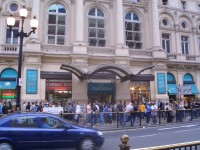 The Trocadero is a massive indoor games arcade near Leicester square originally built as a restaurant but most recently used as an exhibition and entertainment space. The complex incorporates a number of historic London buildings, including the London Pavilion, that have in the past hosted the Palace of Varieties, the New Private Subscription Theatre, the Royal Albion Theatre, the New Queen's Theatre, the Argyll Subscription Rooms, the Trocadero Music Hall, the Royal Trocadero Music Hall, the Eden Theatre and the Trocadero Restaurant. The name Trocadero indirectly derives from the Battle of Trocadero in 1823, through the Palais du Trocadero in Paris, named for the French victory.
The Trocadero is a massive indoor games arcade near Leicester square originally built as a restaurant but most recently used as an exhibition and entertainment space. The complex incorporates a number of historic London buildings, including the London Pavilion, that have in the past hosted the Palace of Varieties, the New Private Subscription Theatre, the Royal Albion Theatre, the New Queen's Theatre, the Argyll Subscription Rooms, the Trocadero Music Hall, the Royal Trocadero Music Hall, the Eden Theatre and the Trocadero Restaurant. The name Trocadero indirectly derives from the Battle of Trocadero in 1823, through the Palais du Trocadero in Paris, named for the French victory.
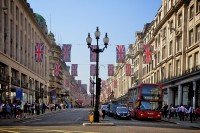 Regent Street is one of the major shopping streets in London's West End, well known to tourists and Londoners alike, and famous for its Christmas illuminations. It is named after the Prince Regent (later George IV), and is commonly associated with the architect John Nash, whose street layout survives, although all his original buildings except All Souls Church have since been replaced.
Regent Street is one of the major shopping streets in London's West End, well known to tourists and Londoners alike, and famous for its Christmas illuminations. It is named after the Prince Regent (later George IV), and is commonly associated with the architect John Nash, whose street layout survives, although all his original buildings except All Souls Church have since been replaced.
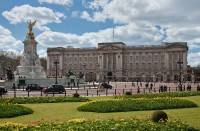 Buckingham Palace, in London, is the principal residence and office of the British monarch (The Queen). Located in the City of Westminster, the palace is a setting for state occasions and royal hospitality. It has been a focus for the British people at times of national rejoicing and crisis.
Buckingham Palace, in London, is the principal residence and office of the British monarch (The Queen). Located in the City of Westminster, the palace is a setting for state occasions and royal hospitality. It has been a focus for the British people at times of national rejoicing and crisis.
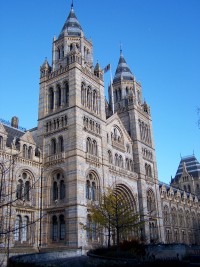 The Natural History Museum is home to life and earth science specimens comprising some 70 million items within five main collections: Botany, Entomology,Mineralogy, Palaeontology and Zoology. The museum is a world-renowned centre of research, specialising in taxonomy, identification and conservation. Given the age of the institution, many of the collections have great historical as well as scientific value, such as specimens collected by Darwin.
The Natural History Museum is home to life and earth science specimens comprising some 70 million items within five main collections: Botany, Entomology,Mineralogy, Palaeontology and Zoology. The museum is a world-renowned centre of research, specialising in taxonomy, identification and conservation. Given the age of the institution, many of the collections have great historical as well as scientific value, such as specimens collected by Darwin.
 The London Underground (often shortened to "the tube") is a rapid transit system, serving a large part of Greater London and some parts of Buckinghamshire, Hertfordshire and Essex. It incorporates the oldest section of underground railway in the world, which opened in 1863 and now forms part of the Circle, Hammersmith & City, and Metropolitan lines and the first line to operate electric trains, in 1890, now part of the Northern line
Using the London underground system is a massive part of being a tourist in London and you will be using it every day to get around London.
The London Underground (often shortened to "the tube") is a rapid transit system, serving a large part of Greater London and some parts of Buckinghamshire, Hertfordshire and Essex. It incorporates the oldest section of underground railway in the world, which opened in 1863 and now forms part of the Circle, Hammersmith & City, and Metropolitan lines and the first line to operate electric trains, in 1890, now part of the Northern line
Using the London underground system is a massive part of being a tourist in London and you will be using it every day to get around London.
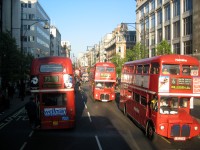 Oxford Street is a major thoroughfare in the City of Westminster in theWest End of London, United Kingdom. It is Europe's busiest shoppingstreet, and as of 2011 had approximately 300 shops. The street was formerly part of the London-Oxford road which began at Newgate, City of London, and was known as the Oxford Road.
Oxford Street is a major thoroughfare in the City of Westminster in theWest End of London, United Kingdom. It is Europe's busiest shoppingstreet, and as of 2011 had approximately 300 shops. The street was formerly part of the London-Oxford road which began at Newgate, City of London, and was known as the Oxford Road.
 Hyde Park is one of the largest parks in central London and one of the Royal Parks of London, famous for its Speakers' Corner.
The park is divided in two by the Serpentine. The park is contiguous with Kensington Gardens; although often still assumed to be part of Hyde Park, Kensington Gardens has been technically separate since 1728, when Queen Caroline made a division between the two. Hyde Park is the largest of four parks which form a chain from the entrance of Kensington Palace through Kensington Gardens and Hyde Park, via Hyde Park Corner and Green Park, past the main entrance to Buckingham Palace and then on through Saint James's Park to Horse Guards Parade in Whitehall.
Hyde Park is one of the largest parks in central London and one of the Royal Parks of London, famous for its Speakers' Corner.
The park is divided in two by the Serpentine. The park is contiguous with Kensington Gardens; although often still assumed to be part of Hyde Park, Kensington Gardens has been technically separate since 1728, when Queen Caroline made a division between the two. Hyde Park is the largest of four parks which form a chain from the entrance of Kensington Palace through Kensington Gardens and Hyde Park, via Hyde Park Corner and Green Park, past the main entrance to Buckingham Palace and then on through Saint James's Park to Horse Guards Parade in Whitehall.
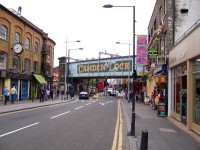 Camden Town is a district of Inner London in northwest London and the central neighbourhood of the London Borough of Camden. It is located 2.4 miles north-northwest of Charing Cross and is one of the 35 major centres identified in the London Plan. It was laid out as a residential district from 1791 and was originally part of the manor of Kentish Town and the parish of St Pancras, Middlesex. The town became an important location during the early development of the railways and is also located on the London canal network. Its industrial heritage has made way for retail, tourism and entertainment, including a number of internationally renowned markets and music venues that are strongly associated with alternative culture.
Camden Town is a district of Inner London in northwest London and the central neighbourhood of the London Borough of Camden. It is located 2.4 miles north-northwest of Charing Cross and is one of the 35 major centres identified in the London Plan. It was laid out as a residential district from 1791 and was originally part of the manor of Kentish Town and the parish of St Pancras, Middlesex. The town became an important location during the early development of the railways and is also located on the London canal network. Its industrial heritage has made way for retail, tourism and entertainment, including a number of internationally renowned markets and music venues that are strongly associated with alternative culture.

